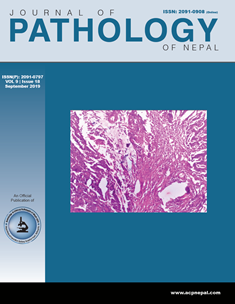Understanding the gleason grading system and its changes
DOI:
https://doi.org/10.3126/jpn.v9i2.25723Keywords:
Carcinoma, Gleason grade, International Society of Urological Pathology, ProstateAbstract
Gleason Grading System is the most widely used grading system used for prostatic carcinoma. The five basic grade patterns are used to generate a histologic score, which can range from 2 to 10 (including primary and secondary patterns). The original Gleason Grading System was used to grade acinar adenocarcinoma based on architectural features and it has been correlated with excellent clinical outcomes. Since 1960s, after the discovery of the original Gleason Grading System, a modified version of the Gleason Grading System was introduced in the International Society of Urological Pathology 2005 which came up with many changes including elimination of Gleason pattern 1. The ISUP 2005 was further updated in 2014 to provide more accurate stratification of prostatic carcinoma. The new Gleason Grade Group 1 to 5 has been introduced and it has little resemblance to the original Gleason system. This Gleason Grade Group has been accepted by the 2016 World Health Organization classification of tumors of the prostate.
For a needle biopsy, high grade component of any quantity should be included in the Gleason score as it indicates a high probability of finding significant high grade tumor in the prostate. By understanding the principles and practice of this grading system, the pathology report has to clearly indicate which system is adopted in the reporting. This review discusses GGS and its recent development focusing on major changes over the years that led to the new Grade Group system proposed by the 2014 ISUP consensus.
Downloads
Downloads
Published
How to Cite
Issue
Section
License
This license enables reusers to distribute, remix, adapt, and build upon the material in any medium or format, so long as attribution is given to the creator. The license allows for commercial use.




